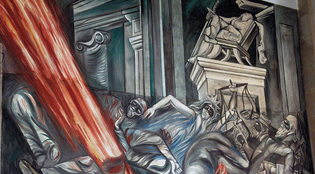 loading
loading
Arts & CultureObject lessonOn and off her pedestal Judith Resnik and Dennis Curtis ’66LLB are professors at Yale Law School.  Courtesy Mexican National Institute of Fine Arts and LiteratureThis 1941 mural by Mexican artist José Clemente Orozco is a play on conventional depictions of Justice. View full image
This scene from a 1941 mural by José Clemente Orozco greets visitors entering the Supreme Court of Mexico. Amidst a chaotic group of evildoers, Orozco has placed two female images, recognizable as “Justice” because one has a sword and the other scales. But unlike the familiar rendition of an imposing woman at center stage, these “Justices” are disconcerting. One, elevated on a pedestal, lies back—inattentive if not asleep—her sword dangling while disorder surrounds her. Below, a masked Justice is jostled while two men, similarly masked, grab at her scales. Are they common thieves, or judges and lawyers, as the papers they hold suggest? If the Justice above is oblivious, the one below is either overborne by the chaos or a willing participant in the melee. More commanding Justices, marked by scales and swords, have adorned government buildings from fourteenth-century town halls to twentieth-century courthouses around the world. In the Renaissance, Justice was typically portrayed alongside Prudence, Fortitude, and Temperance, also virtues of governance, but who have since fallen out of the visual vernacular. The legibility of the Mexican imagery is evidence of Justice’s remarkable run as political propaganda.
Court judgments are acts of force, whether transferring property among civil claimants or depriving criminal defendants of liberty. Governments of all kinds aim to demonstrate their ability to provide peace and security and to legitimate such force. In the Renaissance, judges served as loyal servants of the state. But even then, they were publicly instructed to “hear the other side” and not to favor the rich or poor. Democracy radically reconceived the role of the judge by insisting on independence and imposing obligations for open hearings that resulted in shifting power to an observant public. In the twentieth century, new bodies of law emerged, and women and men of all colors gained rights in many countries to be in courts as litigants, witnesses, jurors, lawyers, and judges. Dockets grew, and courthouses multiplied. But as the Orozco mural suggests, dark undercurrents may flow behind imposing courthouse façades. The Orozco murals tell us that democracy not only changed courts but also challenged them. Deep problems arise when governments neither fund judicial access adequately nor control elites who profit from privileged positions. The murals offer a display, rare inside a courthouse, of law’s failings. Orozco’s critique was not lost on his audience. The unveiling of the first 1,400-square-foot segment resulted in the rest of the commission’s cancellation. Decades later, however, appreciation for his work prompted the Mexican Supreme Court to adorn its brochure with his murals. Further, when commissioning new art, the Court welcomed painful imagery such as La historia de la justicia en México, by Rafael Cauduro. Completed in 2009, the murals greet visitors with graphic details of “The Seven Major Crimes,” including rape, homicide, and torture. What should people see when they enter courthouses? Around the world, distinguished architects have designed celebratory glass edifices, explained as denoting law’s accessibility and transparency. Few offer references such as these to remind judges and audience of the challenges entailed in law’s struggles to secure safety and justice.
The comment period has expired.
|
|